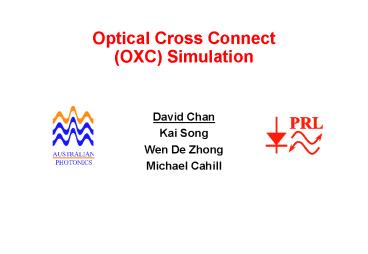Optical Cross Connect OXC Simulation - PowerPoint PPT Presentation
1 / 18
Title:
Optical Cross Connect OXC Simulation
Description:
Develop a module that will extend Kai Song's Matlab-based ... heterodyne and homodyne crosstalk, switch leakage etc. A. B. C. D. E. F. G. H. J. K. L. M. N. P ... – PowerPoint PPT presentation
Number of Views:1603
Avg rating:3.0/5.0
Title: Optical Cross Connect OXC Simulation
1
Optical Cross Connect(OXC) Simulation
- David Chan
- Kai Song
- Wen De Zhong
- Michael Cahill
2
Outline
- Objective of OXC simulation
- Issues in modelling an OXC
- Development of OXC simulation module
- Preliminary Results
- Future Work
3
Objective of OXC Simulator
- Develop a module that will extend Kai Songs
Matlab-based simulation tool to model OXCs - calculation of system impairments for traffic
streams passing through OXC - comparison of OXC architectures using
user-specified or generic models - analysis of OXC performance and dependence on
component specifications using user-defined
values
4
Calculation of System Impairments
- system impairments for traffic streams passing
through OXC may be calculated - e.g. heterodyne and homodyne crosstalk, switch
leakage etc.
5
Comparison of OXC Architecture
- OXC architecture may be specified, e.g.
(i)
(ii)
(iii)
6
Component Specification
- basic component specifications may be specified,
e.g. - also filters, optical amplifiers, gratings,
couplers, etc.
(iii) MUX
(i) 2X2 WXC
(ii) DMUX
(iv) Splitter
7
(Ultimate) Objective of OXC Simulator
- Useful component in the suite of WDM system
simulator tools
8
OXC Modelling Issues
- Number of input fibres and wavelength channels
per fibre - Architectural and Component Issues
- OXC DEMUX and MUX
- WDM demux, splitter plus filters
- OXC switching fabric
- splitters plus gates, NN opto-mechanical
switches, Clos network of 22 switches, broadcast
select (star coupler plus tunable filters or
wavelength converters), FBGs plus circulators - Connection between DEMUX/MUX and switching fabric
- conventional (see figures in slide 5), loop back
- Each of the above will have an impact on the
performance of the OXC
9
Development of OXC Simulation Module
- As a first cut, choose the following
implementation - any number of input fibres (assume same number of
outputs) - any number of wavelength channels per fibre
- WDM DEMUX and MUX, conventionally connected to
switches - NN space switches for any value of N
- Outputs power spectra, eye diagrams and Q values
10
OXC Simulation Module
- module generates the OXC switching fabric based
on - number of input fibres, N (determines dimension
of switches) - number of channels per fibre, M (determines
number of switches)
11
Preliminary Results
- An OXC with 4 input fibres and 4 channels per
fibre - Four 4 4 switches required
- Each 4 4 switch has 4! or 24 possible switching
states - Switches 1 3 totally crossed, 2 4 totally
barred
Input Source Average Power Input Fibre
Output Input Source Average Power Input
Fibre Output 1 0 dBm 1 4
9 -5 dBm 3 2 2
0 dBm 1 1 10 -5 dBm 3 3
3 0 dBm 1 4 11
-5 dBm 3 2 4 0 dBm 1 1
12 -5 dBm 3 3 5
5 dBm 2 3 13 10 dBm 4 1
6 5 dBm 2 2 14
10 dBm 4 4 7 5 dBm 2 3
15 10 dBm 4 1 8 5
dBm 2 2 16 10 dBm 4 4
12
Preliminary Results Input Power Spectra
Web note Fibres 2-4 available in full download
version
13
Preliminary Results Output Power Spectra
Web note Fibres 2-4 available in full download
version
14
Preliminary Results (II)
- An OXC with 5 input fibres and 3 channels per
fibre - Three 5 5 switches required
- Each 5 5 switch has 5! possible switching
states - Switches 1 3 totally crossed, 2 totally
barred
Input Source Average Power Input Fibre
Output Input Source Average Power Input
Fibre Output 1 0 dBm 1 5
9 -5 dBm 3 3 2
0 dBm 1 1 10 -5 dBm 4 2
3 0 dBm 1 5 11
-5 dBm 4 4 4 0 dBm 2 4
12 -5 dBm 4 2 5
5 dBm 2 2 13 10 dBm 5 1
6 5 dBm 2 4 14
10 dBm 5 5 7 5 dBm 3 3
15 10 dBm 5 1 8 5
dBm 3 3
15
Preliminary Results (II) Input Power Spectra
Web note Fibres 2-4 available in full download
version
16
Preliminary Results (II) Output Power Spectra
Web note Fibres 2-4 available in full download
version
17
Future Work
- Develop more detailed models of OXC
- increase complexity of OXC architecture
- incorporate more detailed component models
- Verification and comparison with analytical
results - Improve module and optimise code for speed
- Investigate effect of cascading OXCs
18
References
1) T. Gyselings et al., Crosstalk analysis of
multiwavelength optical cross connects, JLT,
vol. 17 no. 8, pp. 1273 - 1283, 1999. 2) P.
Ohlen, Noise and crosstalk limitations in
optical cross-connects with reshaping wavelength
converters, JLT, vol. 17 no. 8, pp. 1295 - 1301,
1999. 3) N. Antoniades et. al., An architecture
for a wavelength interchanging cross-connect
utilizing parametric wavelength converters, JLT,
vol. 17 no. 7, pp. 1113 - 1125. 4) C. Herben et
al., Crosstalk performance of integrated optical
cross connects, JLT, vol. 17 no. 7, pp. 1126 -
1134, 1999. 5) E. Iannone et. al., Modelling of
in-band crosstalk in WDM optical networks, JLT,
vol. 17 no. 7, pp. 1135 - 1141, 1999. 6) Y. Shen
et al., Coherent and incoherent crosstalk in WDM
optical networks, JLT, vol. 17 no. 5, pp. 759 -
764, 1999. 7) L. Gillner et. al., Scalability
of optical multiwavelength switching networks
crosstalk analysis, JLT, vol. 17 no. 1, pp. 59 -
67, 1999. 8) S. Dods et. al., Homodyne
crosstalk in WDM ring and bus networks, IEEE
PTL, vol. 9, pp. 1285 - 1287, 1997.































